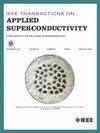JSNPE: A Digital Superconducting Spiking Neural Processing Element
IF 1.8
3区 物理与天体物理
Q3 ENGINEERING, ELECTRICAL & ELECTRONIC
引用次数: 0
Abstract
Superconducting electronic devices are considered a compelling candidate for designing neuromorphic hardware due to their similar behavioral characteristics. Previous works have shown high potential for applying them to design spiking neural networks. However, convincing schemes remain lacking. This article proposes a Josephson junction (JJ)–based spiking neural processing element, JSNPE, a digital scheme composed of a neural and synaptic module. The neuron is a concise quasidigital circuit with three JJs. It operates asynchronously and realizes the integrate-and-fire model. The synapse is a digital circuit constructed with superconducting rapid single flux quantum devices. Compared to previous designs, JSNPE facilitates network scalability, exhibits higher computational resolution, and enables easier weight configuration. To validate the design, we conducted inference tasks on the IRIS and MNIST datasets using WRspice simulation, with inference parameters obtained through software-based training. The analysis indicates that the inference network can achieve a classification accuracy of 96.7% on IRIS, while for MNIST, the classification accuracy for digit “0” reached 94%. We also evaluated the performance and energy efficiency of JSNPE, demonstrating that JSNPE could achieve significant improvements in both metrics compared to complementary metal oxide semiconductor designs.数字超导脉冲神经处理元件
超导电子器件由于其相似的行为特征而被认为是设计神经形态硬件的有力候选者。以前的工作已经显示出将它们应用于设计尖峰神经网络的巨大潜力。然而,令人信服的方案仍然缺乏。本文提出了一种基于约瑟夫森结(Josephson junction, JJ)的脉冲神经处理单元(spike neural processing element, JSNPE),一种由神经模块和突触模块组成的数字方案。神经元是一个简洁的准数字电路,有三个jj。它异步操作并实现了集成和激活模型。突触是由超导快速单通量量子器件构成的数字电路。与以前的设计相比,JSNPE促进了网络可伸缩性,具有更高的计算分辨率,并且支持更容易的权重配置。为了验证设计,我们使用WRspice仿真对IRIS和MNIST数据集进行了推理任务,并通过软件训练获得了推理参数。分析表明,该推理网络在IRIS上的分类准确率为96.7%,而在MNIST上,对数字“0”的分类准确率达到94%。我们还评估了JSNPE的性能和能源效率,证明与互补的金属氧化物半导体设计相比,JSNPE在这两个指标上都可以实现显着的改进。
本文章由计算机程序翻译,如有差异,请以英文原文为准。
求助全文
约1分钟内获得全文
求助全文
来源期刊

IEEE Transactions on Applied Superconductivity
工程技术-工程:电子与电气
CiteScore
3.50
自引率
33.30%
发文量
650
审稿时长
2.3 months
期刊介绍:
IEEE Transactions on Applied Superconductivity (TAS) contains articles on the applications of superconductivity and other relevant technology. Electronic applications include analog and digital circuits employing thin films and active devices such as Josephson junctions. Large scale applications include magnets for power applications such as motors and generators, for magnetic resonance, for accelerators, and cable applications such as power transmission.
 求助内容:
求助内容: 应助结果提醒方式:
应助结果提醒方式:


